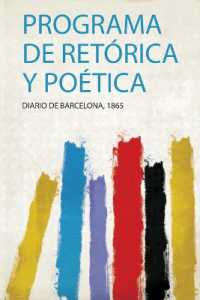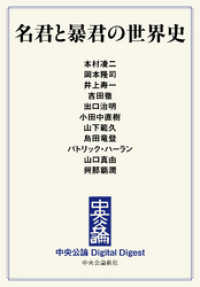- ホーム
- > 洋書
- > 英文書
- > Cinema / Film
Full Description
Bridging landmark territory in film studies, Psycho-Sexual is the first book to apply Alfred Hitchcock's legacy to three key directors of 1970s Hollywood-Brian De Palma, Martin Scorsese, and William Friedkin-whose work suggests the pornographic male gaze that emerged in Hitchcock's depiction of the voyeuristic, homoerotically inclined American man. Combining queer theory with a psychoanalytic perspective, David Greven begins with a reconsideration of Psycho and the 1956 remake of The Man Who Knew Too Much to introduce the filmmaker's evolutionary development of American masculinity.
Psycho-Sexual probes De Palma's early Vietnam War draft-dodger comedies as well as his film Dressed to Kill, along with Scorsese's Taxi Driver and Friedkin's Cruising as reactions to and inventive elaborations upon Hitchcock's gendered themes and aesthetic approaches. Greven demonstrates how the significant political achievement of these films arises from a deeply disturbing, violent, even sorrowful psychological and social context. Engaging with contemporary theories of pornography while establishing pornography's emergence during the classical Hollywood era, Greven argues that New Hollywood filmmakers seized upon Hitchcock's radical decentering of heterosexual male dominance. The resulting images of heterosexual male ambivalence allowed for an investment in same-sex desire; an aura of homophobia became informed by a fascination with the homoerotic. Psycho-Sexual also explores the broader gender crisis and disorganization that permeated the Cold War and New Hollywood eras, reimagining the defining premises of Hitchcock criticism.
Contents
Acknowledgments
Introduction. Hitchcock, Gender, and the New Hollywood
Chapter One. Cruising, Hysteria, Knowledge: The Man Who Knew Too Much (1956)
Chapter Two. "You Are Alone Here, Aren't You?": Psycho's Doubles
Chapter Three. Blank Screens: Psycho and the Pornographic Gaze
Chapter Four. Misfortune and Men's Eyes: Three Early De Palma Comedies
Chapter Five. A Sense of Vertigo: Taxi Driver
Chapter Six. Mirror Shades: Cruising
Chapter Seven. The Gender Museum: Dressed to Kill
Coda: Ideology at an Impasse
Notes
Bibliography
Index







